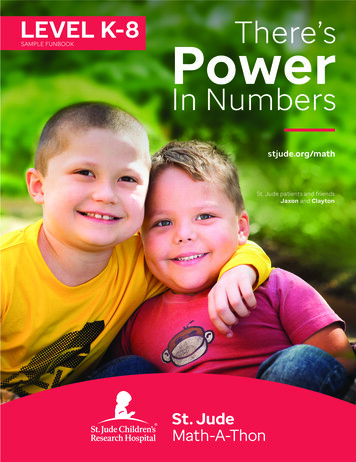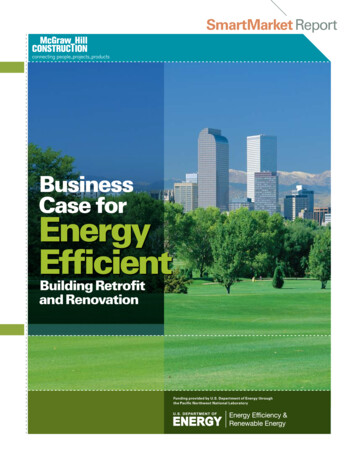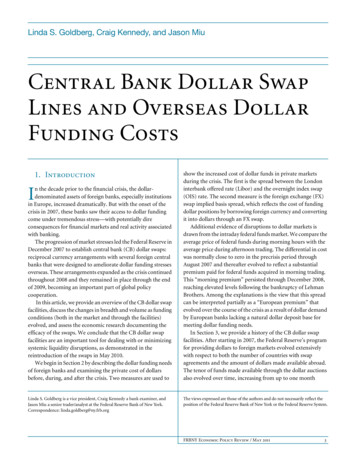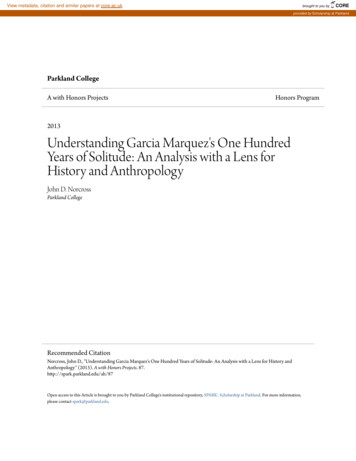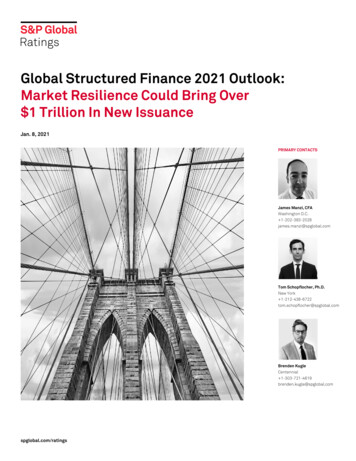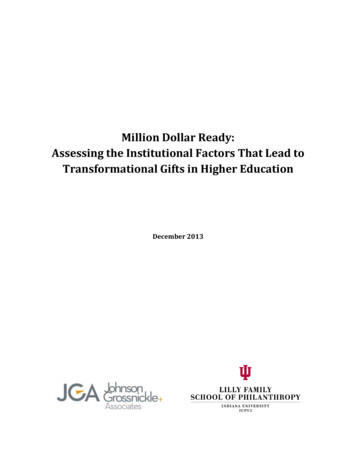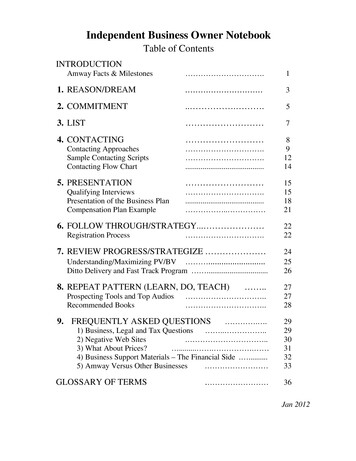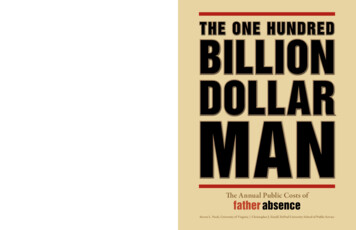
Transcription
THE ONE HUNDREDBILLIONDOLLARMANThe Annual Public Costs offather absence 2008 National Fatherhood Initiative — Released June 2008Steven L. Nock, University of Virginia Christopher J. Einolf, DePaul University School of Public Service
About the Authors. 2Executive Summary. 3Introduction. 4Father Absence: The Causes and Costs. 5THE DIRECT COSTS OF FATHER ABSENCE. . 7THE INDIRECT COSTS OF FATHER ABSENCE. 7WHAT THIS STUDY MEASURES AND HOW. . 8ANNUAL SPENDING CHART. 10 DEVELOPMENTAL OUTCOMES FORCHILDREN AND LONG-TERM COSTS. 11Conclusion.13Appendix: Cost Calculations. 14 2008 National Fatherhood Initiative www.fatherhood.org The Costs of Father Absencethe costs of father absencetable of contents1
about the authorsSteven L. NockSteven Nock passed away on January 20, 2008, shortly after completing this report.He was a Commonwealth Professor, Professor of Sociology, and Director of the MarriageMatters project at the University of Virginia. He earned his Ph.D. at the University ofMassachusetts-Amherst in 1976.Mr. Nock authored books and articles about the causes and consequences of changein the American family. He has investigated issues of privacy, unmarried fatherhood,cohabitation, commitment, divorce, and marriage. His most recent book, Marriage inMen’s Lives, won the William J. Good Book Award from the American SociologicalAssociation for the most outstanding contribution to family scholarship in 1999.He focused on the intersection of social science and public policy concerninghouseholds and families in America.Mr. Nock taught courses on the family at the introductory and advanced undergraduate,and advanced graduate levels. He won the 1991-1992 All-University OutstandingTeacher of the Year Award.His latest research was the Marriage Matters project, which examines the legalinnovation known as Covenant Marriage in Louisiana, Arizona, and Arkansas.This report is dedicated to the memory of Steven L. NockChristopher J. EinolfChris Einolf received a Ph.D. in sociology from the University of Virginia in2006. In addition to sociology of the family, Dr. Einolf studies charitable givingand volunteering. In the fall of 2008, he will begin a position as Assistant Professorin the School of Public Service at DePaul University.About National Fatherhood InitiativeNational Fatherhood Initiative (NFI), founded in 1994, works in every sector and at every level of society to engage fathers in the lives of theirchildren. NFI is one of the leading producers of research on the causes and consequences of father absence, public opinion on family issues,and trends in family structure and marriage. NFI’s flagship research publication, Father Facts, is the leading source of fatherhood informationand statistics for the press, public policy experts, and government officials. NFI’s Pop’s Culture: A National Survey of Dads’ Attitudes onFathering and With This Ring: A National Survey on Marriage in America are two of the most comprehensive national surveys that havebeen published in recent years on American attitudes towards fatherhood and marriage. NFI’s national public service advertising campaignpromoting father involvement has generated television, radio, print, Internet, and outdoor advertising valued at over 500 million. Throughits resource center, FatherSOURCE , NFI offers a wide range of innovative resources to assist fathers and organizations interested in reachingand supporting fathers. Through its “three-e” strategy of educating, equipping, and engaging, NFI works with businesses, prisons, churches,schools, community-based organizations, hospitals, and military installations to connect organizations and fathers with the resources theyneed to ensure that all children receive the love, nurture, and guidance of involved, responsible, and committed fathers.2The Costs of Father Absence www.fatherhood.org 2008 National Fatherhood Initiative
1F ather absence has risengreatly in the last four decades.Between 1960 and 2006, the number of childrenliving in single-mother families went from8 percent to 23.3 percent, and 34 percent ofchildren currently live absent theirbiological father.2F ather absencecontributes to family poverty.In 2003, 39.3 percent of single-mother familieslived in poverty, but only 8.8 percent of fatherpresent families lived in poverty. Some, butnot all, of the poverty of single-mother familiesis a result of father absence. is is the first study to date* to estimate theThcost of father absence to U.S. taxpayers viafederal expenditures on programs to assistsingle-mother families.* To the best of the authors’ knowledge as of June, 2008. The Federal Governmentspent at least 99.8 billionproviding assistance to father-absentfamilies in 2006. 99.8 billion is the amount3the Federal government spent on thirteen meanstested benefit programs and on child supportenforcement for single mothers. These programsinclude the Earned Income Tax Credit,Temporary Assistance for Needy Families(TANF), child support enforcement, foodand nutrition programs, housing programs,Medicaid, and the State Children’s HealthInsurance Plan (SCHIP).T he 99.8 billion cost is a conservativeestimate, as it leaves out 3 significant,but hard to measure, sources of costs:4 ederal benefits programs that benefit wholeFcommunities, or that benefit individuals regardlessof income.I ndirect costs related to the poor outcomes of childrenof single-mother families, such as greater use ofmental and physical health services, and a higherrate of involvement in the juvenile justice system. ong-term costs in reduced tax income due to theLlower earnings of children of single-parent families,and long-term costs due to the higher incarcerationof children of single-parent families. ecause single mothers differ fromBmarried mothers in a number of waysthat contribute to poverty, it is difficult to5determine how much of the 99.8 billion inexpenditures is a direct consequence of father absenceversus a consequence of the other factors that contributeto the poverty of single-mother homes. However, sincefather absence has become so widespread and thereare 99.8 billion worth of direct costs to taxpayersassociated with it, policymakers should devote moreattention to reducing father absence.executive summaryThis study, the first of its kind, provides an estimate of the taxpayer costs of fatherabsence. More precisely, it estimates the annual expenditures made by the federal government tosupport father-absent homes. These federal expenditures include those made on thirteen means-testedantipoverty programs and child support enforcement, and the total expenditures add up to a startling 99.8 billion.F urther research is needed to morethoroughly calculate both the directand indirect costs (such as increased use of mental6health services and higher incarceration rates forchildren from father-absent homes) that result fromfather absence. These costs may be significant andcould be used to better inform policymakers of specificpolicy recommendations for combating father absence. 2008 National Fatherhood Initiative www.fatherhood.org The Costs of Father Absence3
introductionIn 1960, about one in thirteen children in American under age 18 (8.0 percent) lived with hisor her mother and no father. In 2006, the fraction was one in four (23.3 percent).1 Furthermore,34 percent of children live absent their biological father.2 Today, half of all children3, and 80 percentof African American children, can expect to spend at least part of their childhood living apartfrom their fathers.4 This dramatic increase in the living arrangements of children is part of alarger demographic revolution that has attracted extensive interest and research. The short storyis that in the course of about half a century, many of the foundational patterns of children’s livingarrangements have been altered. In almost all cases, those changes involve growing impermanencefor children, fewer adults, greater chances of poverty, and weak inter-generational connections.A profound change in the order of events in the lives of adults is the primary reason. Adults nowmarry much later than they did forty years ago, and many forgo marriage in favor of informal,usually temporary cohabiting relationships. The result is predictably high rates of births to singlewomen (currently about 34 percent of births), and births to cohabiting couples, some of whomsubsequently marry, some of whom separate. Add these to the high divorce rate in America, andthe statistics cited above are much more understandable.5To help place the changing patterns of children’s living arrangement in historical perspective,the following graph (Figure 1) shows the percentage of American children (under age 18) living inhomes absent a biological, step, or adoptive father. As the chart indicates, the past 40 years has seena meteoric rise in the overall fraction of children living with a mother only, although it has leveledoff in very recent years.6FIGURE 1. Percentage of Children Living in Father-Absent Homes, 1960 to 2004Percentage of Children Living in Father-Absent Homes, 1960 to 02004U.S. Bureau of the Census, 2007. Households and Families, Historical Statistics, Table CH1. 1.csvU.S. Bureau of the Census, 2005. The Living Arrangements of Children: 2001. Kreider, Rose, and Fields, Jason.3 Bumpass, L.L. and J.A. Sweet. “Children’s Experience in Single-Parent Families: Implications of Cohabitation and Marital Transitions.” Family Planning Perspectives, 21 (1989): 256-260.4“ Report of Final Natality Statistics, 1996.” Monthly Vital Statistics Report 46, no. 11, Supplement (Washington, D.C.: U.S. Department of Health and Human Services, June 30, 1998);see also, “Turning the Corner on Father Absence in Black America: A Statement from the Morehouse Conference on African-American Families,” Atlanta, GA: Morehouse ResearchInstitute & Institute for American Values (June 1999): 4.5 ndrew J. Cherlin, 2005, “American Marriage in the Early Twenty-First Century,” The Future of Children 15(2):33-55. http://www.futureofchildren.org/usr doc/03 FOC 15-2 fall05 Cherlin.pdf.AFor a discussion of the changing order of cohabitation, birth, and marriage, see Larry Wu and Kelly Musik, 2007, “Stability of Marital and Cohabiting Unions Following a First Birth,”CCPR-019-06, California Center for Population Research, online resource: http://www.ccpr.ucla.edu/ccprwpseries/ccpr 019 06.pdf.6 U.S. Bureau of the Census, 2007, Current Population Reports, Annual Household and Economic Supplements, Table CH-2. m.html.The Costs of Father Absence www.fatherhood.org 2008 National Fatherhood Initiative
The most common reasons for father absence today are divorce, out-of-wedlock births, andincarceration. In the past, widowhood accounted for a greater proportion of father-absent householdsthan today, but currently widows make up only 3.6 percent of female-headed families. The followingtable (Figure 2) traces the changing composition of mother-headed households in America since1960.7 Most evident is the growth of never-married mother households and the decline in widowedmother households. Single-mother households with absent husbands are a declining, yet significantfraction of single-mother households. Some such families are formed when a father is incarcerated.In all likelihood, the reason for the single-mother family matters in terms of the associated need forassistance from others. Divorce, for example, may not cause the same level of economic distress asunmarried motherhood, because divorced fathers pay more child-support than never-married fathers.8FIGURE 2. Single-Mother Families 1960-20067 .S. Bureau of the Census, 2006, Current Population Reports, Table CH-5, “Children Under 18 Years Living With Mother Only, by Marital Status of o/hh-fam/ch5.csv.8Meyer, D., and Judi Bartfield. “Patterns of Child Support Compliance in Wisconsin.” Journal of Marriage and the Family, 60 (May, 1998): 309-318. 2008 National Fatherhood Initiative www.fatherhood.org The Costs of Father Absencefather absence:By “father absence,” we refer to families where a biological, adoptive, or stepfather does not livein the same household with his children. Fathers may be either fully or partially absent from familylife. Fathers may be fully absent because of their death, their incarceration, or their abandonmentof their families. The category of partially absent fathers includes fathers who live in a differenthousehold due to divorce or separation. It also includes fathers who were never married to and nolonger live with their children’s mother, but who maintain some contact with their children. Inmost respects, therefore, a study of father absence is also a consideration of female-headed families.the causes & costsGiven the changing living arrangements of children, it is not surprising that much concern inrecent years has focused on the possible effects of father absence in children’s lives. This literatureis large and growing. Our objective in this report is to tackle a related topic. We ask, “How muchmoney does father absence cost U.S. taxpayers?”5
The first question is howrates returned to 1971 levels.father absence, per se, mightSigle-Rushton and McLanahanhave any predictable costs.(2002) estimated that 46.5Beyond the extensive andpercent of unwed single mothersdifficult-to-measure emotionalwould leave poverty if theycosts that events such as awere married to the father ofdivorce, a separation, ortheir children. Thus, while thea series of impermanentexact number of single-motherrelationships involving onefamilies that would leave povertyor several different men mayis unknown, the best availablehave for a child’s development,studies suggest that a largewe are focused solely on thepercentage would no longer befinancial costs. These ariseliving in poverty if the father oflargely as a result of a lacktheir children were present andof income to sufficiently providecontributing his income to thefor a child and mother. Thehousehold budget.11absence of a father often meansHigher levels of poverty area loss of his income. As we showlater in this report, most scientists who have investigated theimplications of family structure (especially single-motherfederal means-tested programs by single-mother families.These include Temporary Assistance for Needy Familieshouseholds) have shown that the negative outcomes seen(TANF), Medicaid, food stamps, school lunch, Head Start,for children from father-absent homes can be attributedprimarily, but not exclusively, to the lower average incomesenjoyed by such families.and public housing. Also, the majority of the federal fundingfor child support enforcement goes towards enforcement ofpayments from absent fathers to custodial mothers.The effect of father absence on family income is well-Since single mothers are much more likely than marrieddocumented and strong. In 2003, 39.3 percent of single-mothers to live in poverty, they rely on various governmentmother families lived in poverty, but only 8.8 percent offather-present families lived in poverty.9 In 2005, the medianhousehold incomes of married couples with children andassistance programs much more than married parents, anduse government means-tested benefit programs at a higherrate than two-parent families. The cost to the governmentsingle-mothers were 65,906 and 27,244, respectively. 10of funding these programs is substantial. Some of the costsHowever, since some absent fathers are themselves poor,created by father absence, therefore, are related to provisiontheir presence would not lift all poor single-mother familiesof services through means-tested programs. One should keepout of poverty. A series of studies, using advanced statisticalin mind, however, that not all of this cost is a direct resultmethods, have estimated how many families would leaveof father absence, as single mothers differ from marriedpoverty if more fathers were present with their children.mothers in many other ways. For example, single mothersThomas and Sawhill (2002) estimated that 65.4 percentare less educated, have lower-paying jobs, and come fromof single-mother families would leave poverty if marriagelower socioeconomic backgrounds, on average, than married92004 Green Book, G-38.10116strongly related to greater use ofU.S. Census Bureau, 2006, Current Population Reports, P60-231; and Internet site http://pubdb3.census.gov/macro/032006/faminc/new01 000.htm. dam Thomas and Isabel Sawhill, 2002, “For Richer or for Poorer: Marriage as an Antipoverty Strategy,” Journal of Policy Analysis and Management 21(4): 587–99; Wendy Sigle-Rushton and Sara McLanahan,A2002, “For Richer or Poorer?: Marriage as Poverty Alleviation in the United States.” Population 57(3): 509-528.The Costs of Father Absence www.fatherhood.org 2008 National Fatherhood Initiative
mothers. These factors contribute to the high rate of povertyamong single mothers independent of the absence of a fatherin the household.We are not able to provide direct estimates for manycosts generated by father-absence that do not appear untillater in life (e.g., long-term costs of increased incarcerationof children from such families, poorer health, etc.). Nor arewe able to estimate the costs to states and localities. Thisreport provides estimates of the direct costs (in expenditures)to the federal government for households in which there isno father. As such, it is a conservative low-bound estimateof total costs. To our knowledge, this is the first study todate to estimate the cost of father absence to U.S. taxpayersvia federal expenditures. We rely on the existing publishedliterature on the effects of father absence on poverty andother measurable outcomes.The direct costs of father absence.Fourteen major federal government programs provideassistance to households based on their income level. Theseprograms are the EarnedIncome Tax Credit (EITC),Temporary Assistance forNeedy Families (TANF),child care subsidiesfor women in TANF,federal funding for childsupport enforcement,Supplemental SecurityInsurance for low-incomedisabled children, foodstamps, subsidized schoolbreakfasts and lunches,the Women’s, Infants andChildren nutrition program(WIC), Medicaid, theState Children’s HealthInsurance Plan (SCHIP),Head Start, heating and energy assistance, public housing, andSection 8 rental subsidies.Children of single mothers pay their own costs for theabsence of a father, as well. Such children do less well in schoolthan children of two-parent families, have more emotionaland behavioral problems, have worse physical health, are morelikely to use drugs, tobacco, and alcohol, and are more likely tobecome delinquent; teenage girls in single-mother householdsare more likely to become pregnant, and teenage boys in singlemother households are more likely to become teen fathers. Inthe long run, adults who grew up in single-mother householdsattain lower levels of education, earn less, are more likely to beincarcerated, are more likely to have out-of-wedlock births, andare more likely to be divorced. These events are, themselves,also associated with higher demands on collective resources.Therefore, father absence has both immediate and long-termcosts. We are only able to consider the immediate costs. Bydoing so, our estimates are considerably lower than would beobtained by adding the two.The indirect costs of father absence. 2008 National Fatherhood Initiative www.fatherhood.org The Costs of Father AbsenceWhile the absence ofa father creates manyproblems for mothers andchildren, not all of theseproblems carry a financialcost to the government.Other problems do carrycosts, but ones which aredifficult or impossible tocalculate purely in dollarterms. While the cost offather absence estimated inthis paper is high, it is onlya fraction of the total costto the government, and aneven smaller fraction of thetotal cost to society.7
Some of what most would regard as negative outcomesdebate over the degree to which government support ofof father absence are emotional, and are difficult to quantifysingle-mother families would be affected even if the fathersin dollar terms. In the event of a divorce, for example, thewere present.12 Overall, however, children of fatherlessstress that divorce and abandonment places on mothers, thefamilies use mental health services at a higher rate thanfeelings of loss that father absence places on children, thechildren of two-parent families, have more behaviorabsence of emotional support from fathers, and the risksproblems at school, and are more likely to enter the juvenilejustice system. They do less well at school, and schools mayto the physical and emotional health of divorced fathershave to make additional efforts to educate them. Their higherare examples of such costs. In the long run, children fromsingle-mother families may feel anger or resentment towardstheir fathers, or may have weak adult relationships withtheir fathers. They are also more likely to have relationshipdifficulties as adults and get divorced. While a significantuse of drugs, alcohol, and tobacco, and their poorer physicaland mental health, may cause them to use medical servicesmore than children of two-parent families.In the long run, the negative effects on child developmentsource of suffering, these negative effects do not carry amay cause children from fatherless families to incur costsfinancial cost by themselves.as adults. Children of single-mother families have lowerThere are also consequences of father absence that haveimplied indirect consequences for government programs.The literature on this subject is extensive, and there is aeducational attainment and lower wages, which translatesinto lower tax revenue and higher use of government services.Children of father-absent families are more likely to beincarcerated. Children of father-absent families are lesslikely to care for their fathers when they become elderly,and the government takes on some of the cost of caringfor these men.What this study measures and how.Calculating the indirect costs of father absence isextremely complex, and requires many untested assumptions.Such an effort is beyond the scope of our study. Maynard(1996) and Hoffman (2006) calculated some of the indirectcosts of teen pregnancy, but their studies involved a teamof researchers who spent hundreds of hours doing originalresearch.13 Calculating these indirect costs will be left tofuture studies.The most obvious effect of father absence is the effect ithas on household income, and the corresponding increasein single-mother households’ use of means-tested benefitprograms. The best overall aggregate estimate available isthat 20.1 percent of single mothers would leave povertyif marriage rates returned to what they were in 1970.14812 For a review of this debate, see Paul R. Amato,2005, “The Impact of Family Formation Change on the Cognitive, Social, and Emotional Well-Being of the Next Generation,” Future of Children 15(2): 75-96.13 ebecca Maynard, ed., 1996, Kids Having Kids: Economic Costs and Social Consequences of Teen Pregnancy (Washington, DC: Urban Institute); and Saul Hoffman, 2006,RBy the Numbers: the Public Cost of Teen Childbearing (Washington, DC: The National Campaign to Prevent Teen Pregnancy).14Thomas and Sawhill, 2002 (note 9).The Costs of Father Absence www.fatherhood.org 2008 National Fatherhood Initiative
In a comprehensive review of federal programs that haveassisted children over the last three decades, a recent reportby the Urban Institute lists over one hundred programs.15Some of these programs are no longer in existence. Othersprovide services to whole communities, not individualhouseholds, and a change in the poverty structure of singleparent families would not affect the amounts these programsspend. There are fourteen programs for which eligibility isdetermined by the income level of the household. If moresingle mothers were married and had the father’s income aspart of the household income, the government would beable to spend less on these means-tested programs.Few of these fourteen programs provide services onlyto single-mother households. Rather they assist familiesof various compositions, including those without children.The Appendix (page 14) lists sources and calculationmethods for how much each program spends on singlemother households alone. Figure 3, on the following page,lists the name of each federal means-tested program thatprovides benefits to single-mother families, and the totalcost to the government of providing those benefits tosingle-mother families.The basic logic we followed was to first determinethe total federal expenditures on a particular program.We then determined the fraction of program participantswho are in fatherless homes (sometimes this was donefor households, sometimes for individuals). This fraction(or multiplier) was then used to arrive at an estimate ofthe total program costs that go to fatherless households.Children of fatherless families.have more behavioralproblems at school.15 dam Carasso, Eugene Steuerle, and Gillian Reynolds, 2007,AKids’ Share 2007: How Children Fare in the Federal Budget (Washington, DC: Urban Institute). 2008 National Fatherhood Initiative www.fatherhood.org The Costs of Father Absence9
annual spendingFIGURE 3.Annual Spending by Public Programs for Fatherless Families in FY 2006Total Expenditures (FY 2006) for Fatherless HouseholdsProgramType andNameTotalProgram Budget(in millions)PercentFather-AbsentFamiliesCost of Servicesto Father-AbsentFamilies (millions)INCOME SUPPORT:Earned IncomeTax Credit 36,16641.0 14,828Temporary Assistanceto Needy Families 17,14087.5 14,998 4,26889.5 3,820 6,94856.3 3,912Food Stamps 34,74526.8 9,312School Lunch 9,66569.2 6,688Women, Infants,and Children 5,36355.2 2,960 31,90071.0 22,649 4,53935.0 1,589Head Start 6,85148.2 3,302Child Care 4,98187.5 4,358Energy Assistance 3,16037.0 1,169Public Housing 3,56437.0 1,319 24,03737.0 8,894Child SupportEnforcementSupplemental SecurityIncome (children)NUTRITION:HEALTH:Medicaid (children)SCHIP (single-parents)SOCIAL SERVICES:HOUSING:Section 8Rental SubsidiesTOTAL: 193,327 99,798SOURCES. All program expenditures are from the 2007 or 2008 Federal Budget of the United States (for FY 2006 expenditures).All multipliers (percentage female-headed households) are explained and cited in the Appendix (page 14).10The Costs of Father Absence www.fatherhood.org 2008 National Fatherhood Initiative
Our tabulations indicate that the federal government spent 99.8 billion in fiscal year 2006 for direct services forfatherless households. The largest areas of expenses were Medicaid ( 22.6 billion), TANF ( 15.0 billion), and EITC( 14.9 billion). Health care for father-absent households was 24.2 billion, about 4.7 percent of the 516 billion thefederal government spent in FY 2006 on Medicare, Medicaid, and SCHIP (see Figure 4 below). The total spent onfederal means-tested benefits programs for single-mother households (all programs except SCHIP, Medicaid, childsupport enforcement, and SSI) amounted to 50.0 billion, about one-fifth of the 250 billion the federal governmentspent on safety net programs in FY 2006. The 99.8 billion spent directly on assistance to single-mother householdsamounted to nearly 4 percent of the total FY 2006 federal budget of 2.7 trillion.16FIGURE 4. Federal Expenditures (FY 06) on Fatherless HouseholdsFederal Expenditures (FY 06)On Fatherless Households (IN 5,000,000esg8SubsidiinceusHoicctionblSePugyAssiil enmceILFrSuil al outcomes for children and long-term costs.The negative outcomes of children from single parent families follow them into adulthood. Government programs arelikely to be involved at varying states of these young adults’ lives. We cannot estimate the prevalence of such involvement,of course. However, we outline the main themes that are more likely to characterize the development of young adults wholived in fatherless homes than those who lived with two biological parents. These are important to recognize because amore comprehensive accounting of the costs of fatherlessness would need to factor these into the findings.Children of fatherless families are less likely to attend college, are more likely to have children out of wedlock, andare less likely to marry; those who do marry are more likely to divorce. While these negative outcomes have primarilyemotional and social costs, many long-term outcomes also have a financial cost. Children from single-motherhouseholds earn less as adults than children from two-parent families. Children from single-mother householdsare more likely to be poor as adults and use government services. They are more likely to be incarcerated, and theirincarceration poses a steep cost to federal and state governments.While the immediate, short-term costs of father absence are high, the long-term costs are likely to be much higher.However,
8 percent to 23.3 percent, and 34 percent of children currently live absent their biological father. Father absence contributes to family poverty. In 2003, 39.3 percent of single-mother families lower earnings of children of single-parent families, lived in poverty, but only 8.8 perc
